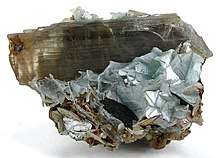Diaspore
Diaspore /ˈdaɪəspɔːr/, also known as diasporite, empholite, kayserite, or tanatarite, is an aluminium oxide hydroxide mineral, α-AlO(OH), crystallizing in the orthorhombic system and isomorphous with goethite. It occurs sometimes as flattened crystals, but usually as lamellar or scaly masses, the flattened surface being a direction of perfect cleavage on which the lustre is markedly pearly in character. It is colorless or greyish-white, yellowish, sometimes violet in color, and varies from translucent to transparent.[3] It may be readily distinguished from other colorless transparent minerals with a perfect cleavage and pearly luster—like mica, talc, brucite, and gypsum— by its greater hardness of 6.5 - 7. The specific gravity is 3.4. When heated before the blowpipe it decrepitates violently, breaking up into white pearly scales.[4]
| Diaspore | |
|---|---|
 | |
| General | |
| Category | Oxide mineral |
| Formula (repeating unit) | α-AlO(OH) |
| Strunz classification | 4.FD.10 |
| Crystal system | Orthorhombic |
| Crystal class | Dipyramidal (mmm) H-M symbol: (2/m 2/m 2/m) |
| Space group | Pbnm |
| Unit cell | a = 4.4007(6) Å b = 9.4253(13) Å c = 2.8452(3) Å; Z = 4 |
| Identification | |
| Color | White, pale gray, colorless, greenish gray, brown, pale yellow, pink, purple; may exhibit color change |
| Crystal habit | Platey, elongated to acicular crystals; also stalactitic, foliated, scaly, disseminated and massive |
| Twinning | Forms heart shaped twins on {021} or pseudohexagonal aggregates |
| Cleavage | {010} perfect, {110} distinct, {100} in traces |
| Fracture | Conchoidal |
| Tenacity | Very brittle |
| Mohs scale hardness | 6.5 - 7 |
| Luster | Adamantine, vitreous, pearly on cleavage faces |
| Diaphaneity | Transparent to translucent |
| Specific gravity | 3.1 - 3.4 |
| Optical properties | Biaxial (+) |
| Refractive index | nα = 1.682 - 1.706 nβ = 1.705 - 1.725 nγ = 1.730 - 1.752 |
| Birefringence | δ = 0.048 |
| Pleochroism | Strong |
| 2V angle | Measured: 84° to 86°, Calculated: 80° to 84° |
| Dispersion | r < v, weak |
| Fusibility | Infusible |
| Solubility | Insoluble |
| Other characteristics | Decrepitates releasing water in closed tube on heating |
| References | [1][2] |
The mineral occurs as an alteration product of corundum or emery and is found in granular limestone and other crystalline rocks. Well-developed crystals are found in the emery deposits of the Urals and at Chester, Massachusetts, and in kaolin at Schemnitz in Hungary. If obtainable in large quantity, it would be of economic importance as a source of aluminium.[4]
Diaspore, along with gibbsite and boehmite, is a major component of the aluminium ore bauxite.[2]
It was first described in 1801 for an occurrence in Mramorsk Zavod, Sverdlovskaya Oblast, Middle Urals, Russia. The name, which was coined by René Just Haüy,[5] is from the Greek for διασπείρειν, to scatter, in allusion to its decrepitation on heating.[1]
Csarite, ottomanite, and zultanite are trade names for gem-quality diaspore (also known as Turkish diaspore) from the İlbir Mountains of southwest Turkey.[6]
References
- Handbook of Mineralogy
- Klein, Cornelis and Cornelius S. Hurlbut, Manual of Mineralogy, Wiley, 1985, 20th ed. p.318 ISBN 0-471-80580-7
- "The Mineral diaspore". minerals.net. Retrieved June 10, 2014.
-

- Spencer 1911.
- Murat Hatipoğlu, Necdet Türk, Steven C. Chamberlain and A. Murat Akgün, Gem-quality transparent diaspore (zultanite) in bauxite deposits of the İlbir Mountains, Menderes Massif, SW Turkey, Mineralium Deposita, Volume 45, Number 2 (2010), 201-205, DOI: 10.1007/s00126-009-0262-2